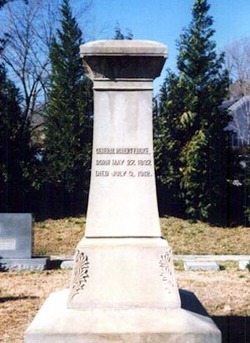Robert Frederick Hoke (in his colonel's uniform)
Robert Frederick Hoke was born in 1837 in Lincolnton, North Carolina. The city and county (Lincoln) was named for Major General Benjamin Lincoln who commanded American troops in the Revolutionary War. The name has nothing to do with northern President Abraham Lincoln. Hoke's father was a successful business man there, but an unsuccessful politician losing his bid for governor of the state in 1844. Robert Hoke graduated from the Kentucky Military Institute and began to manage his family's business ventures, including the iron works, cotton mill, and other's.
Robert began his service in the Confederate Army as a lieutenant in the 1st North Carolina Infantry. His first action occurred at the Battle of Big Bethel where he was commended by his commander, Confederate Colonel Daniel Harvey Hill. Hill praised Hoke for his coolness and judgement under fire. He was quickly promoted to major and then made lieutenant colonel of the 33rd North Carolina Infantry. By 1862, the 33rd was assigned to Lawrence O'Bryan Branch's Brigade.
The regiment saw action at the Battle of New Bern where the colonel was captured, forcing Hoke to assume command of the regiment. Branch praised Hoke for his conduct in the action there. The brigade was then sent to Virginia where they saw action under Lee during the Seven Days' (where he was wounded), Second Manassas, and Sharpsburg (Antietam Campaign). Hoke's regiment performed admiringly at Second Manassas and was praised for his actions there. Following Sharpsburg, Hoke was promoted to colonel and placed in command of the 21st North Carolina Infantry.
Hoke in his brigadier general's uniform (note the wreath around the stars and the double buttons on the coat)
Hoke took command of Isaac Trimble's brigade during the Fredericksburg Campaign and led the unit in a counterattack when Meade's Federal Division broke through Confederate A.P. Hill's lines on the right flank. His horse was struck in the head, throwing Hoke off, and his foot caught in the stirrup dragged him, making him senseless for a short time. Because of his action at Fredericksburg, he earned a promotion to brigadier general to rank from January 17, 1863.
He commanded his brigade during the Battle of Marye's Heights (Second Federicksburg) during the Chancellorsville Campaign on May 4, 1863. A bullet struck Robert in the shoulder area, passed through the head of the humerus (upper arm bone), the shoulder joint, and exited his scapula (shoulder blade). Surgery was performed that day and Hoke was out of action for seven months, returning in December of 1863. He would miss the Gettysburg Campaign because of the severe wound.
Headquarters Flag of Major General Robert Hoke
General Hoke would return to duty commanding troops in North Carolina along the Roanoke River. He saw action near New Bern, although he wasn't completely healed from his wound yet. Hoke commanded his division during the Siege of Plymouth, North Carolina from April 17 until April 20, 1864. There he lost 800 men, but captured 2,000 Federal troops under the command of Brigadier General Henry Wessells. When the Federal troops surrendered, General Wessells told Hoke, "This is the saddest day of my life." Hoke replied, "This is the proudest day of my life."
Robert Hoke's division was next sent to Bermuda Hundred just south of Richmond, Virginia. When first stationed there, he was warned of an approaching Federal force. He replied, "I shall fight them if met from all sides."
His division next saw action under General Robert E. Lee at the Battle of Cold Harbor where Grant's forces suffered devastating losses. He was sent back to North Carolina where he saw action in the fight at Fort Fisher near Wilmington. In January of 1865, he was again absent from his command because of a boil on his face. Upon his return to duty, he fought under Joseph Johnston at the Battle of Bentonville to wrap up his military career. When the army surrendered, Hoke addressed his troops, "The proudest days in all your proud careers was that on which you enlisted as Southern soldiers."
Following the war, he again became a successful business man, becoming director of the North Carolina Railroad Company. He eventually was diagnosed with diabetes. The last few weeks of his life, he was in a diabetic coma and succumbed to the disease on July 3, 1912 in Raleigh, North Carolina. He rests there today in Oakwood Cemetery. Robert Hoke was 75 years old.

Grave of Robert Hoke



I cannot comprehend how these men suffered such terrible wounds (physical; discounting the mental) and continued to return to the battlefield. Wonderful story. I didn't know his name.
ReplyDelete